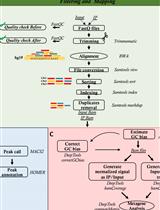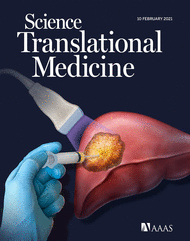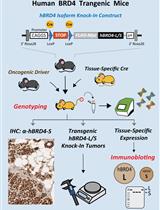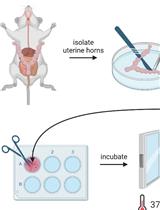- EN - English
- CN - 中文
Detection of Alternative End-Joining in HNSC Cell Lines Using DNA Double-Strand Break Reporter Assays
使用 DNA 双链断裂报告基因检测HNSC细胞系中的替代末端连接
发布: 2022年09月05日第12卷第17期 DOI: 10.21769/BioProtoc.4506 浏览次数: 2230
评审: Pilar Villacampa AlcubierreHongLok LungAnonymous reviewer(s)

相关实验方案

利用OxiDIP-Seq方法对含8-氧代-2′-脱氧鸟苷的受损DNA进行全基因组图谱分析
Francesca Gorini [...] Stefano Amente
2022年11月05日 2670 阅读
Abstract
The main cellular pathways to repair DNA double-strand breaks (DSBs) and protect the integrity of the genome are homologous recombination (HR), non-homologous end-joining (NHEJ), and alternative end-joining (Alt-EJ). Polymerase theta-regulated Alt-EJ is an error-prone DSB repair pathway characterized by microhomology usage. Considering its importance in cancer treatment, technologies for detection of Alt-EJ in cancer cells may facilitate the study of the mechanisms of carcinogenesis and the development of new therapeutic targets. DSB reporter assay is the classical method for detecting Alt-EJ, which is primarily based on components of EJ2-puro cassette integration, I-SceI cleaving, and flow cytometry analysis. Here, we described an assay based on a modified I-Scel plasmid that can screen head and neck squamous cell carcinoma (HNSC) cells that were successfully transfected using selection medium with hygrovetine. We expect that this protocol will improve the fidelity and accuracy of reporter assays.
Graphical abstract:

Schematic overview of the workflow for establishment of Alt-EJ reporters.
Background
DNA double-strand breaks (DSBs) are among the most dangerous forms of DNA lesions and must be efficiently and accurately repaired to prevent genomic instability, tumorigenesis, or cell death (Rahimian et al., 2020; Huang et al., 2021). To deal with endogenous and exogenous threats, cells have evolved multiple DSB repair pathways, mainly including homologous recombination (HR), non-homologous end-joining (NHEJ), and alternative end-joining (Alt-EJ) (Mateos-Gomez et al., 2015; Liu et al., 2019; Wang et al., 2021; Fujii et al., 2022). Of these, Alt-EJ is an error-prone form of DSB repair that leads to chromosomal rearrangements and genomic instability (Liu et al., 2019; Caracciolo et al., 2021; Valikhani et al., 2021). It has been reported that Alt-EJ plays a crucial role in BRCA2-deficient cancers, human papillomavirus-associated cancers, and tumors deficient in the TGF-β signaling pathway (Ceccaldi et al., 2015; Liu et al., 2018, 2019, 2021, 2022; Guix et al., 2022). However, there are still many unknown aspects of Alt-EJ, such as the mechanisms for Alt-EJ regulation, Alt-EJ in tumor development, and DNA damage responses. To further explore the relevant mechanisms and target Alt-EJ for therapeutic benefits, the methods for Alt-EJ detection need to be established and standardized.
Reporter assays, proposed by Gunn et al. (2012), are the most commonly used tools for measuring Alt-EJ (Gunn et al., 2012). EJ2GFP-puro, a non-functional fluorescent protein expression cassette, needs to be integrated into the genome of the cells to be tested. Following the generation of a DSB in the cassette by I-SceI, the expression of the green fluorescent protein is resumed if the cell adopts Alt-EJ for repairing this DSB (Bennardo et al., 2008) (Figure 1). However, due to a lack of suitable screening conditions, the results are inevitably influenced by the efficiency of transfection. Here, we utilized another retroviral system with antibiotic resistance to make DSB and screen for target cells, a method adapted from Muraki et al. (2013). The results are presented in our recent publications (Liu et al., 2018, 2021). This method can avoid the influence of transfection efficiency on the experimental results and improve the accuracy and reproducibility of Alt-EJ study.
Our protocol has been successfully applied in the HNSC cell line SAS, as well as in the glioblastoma cell line U251 (Liu et al., 2018). Theoretically, this protocol could also be applied in other tumor or normal cell lines that require detection of Alt-EJ levels, but further validation is still needed. We can judge the mutational potential of cell chromosomes by testing the levels of Alt-EJ in sorted cells, and thus further explore the development and treatment of relevant cancers.

Figure 1. Diagram of the EJ2GFP-puro cassette. EJ2-GFP contains a GFP expression cassette that is disrupted by the I-SceI cleavage site. Repair by Alt-EJ results in restoration of GFP protein expression.
Materials and Reagents
Pipette tips 10 μL, 200 μL, and 1,250 μL (BEAVER, catalog numbers: 43140, 43143, 43152)
Pipettes set (Gilson, catalog numbers: GFAM00140)
Centrifuge tubes 15 mL and 50 mL (BEAVER, catalog numbers: 43008, 43009)
EP tube 1.5 mL (AXYGEN, catalog numbers: MCT-150-C-S)
Cell culture plate 6-well, 48-well, 24-well, and 96-well (CORNING, catalog numbers: 3516, 3548, 3526, 3599)
100 mm cell culture plates (BEAVER, catalog numbers: 43701)
HNSC cell line SAS (RIKEN BRC, catalog numbers: RCB1974)
Human embryonic kidney cell line HEK293T (ATCC, catalog number: CRL-3216)
Bovine growth serum (HyClone, catalog number: SH30541.03)
Dulbecco’s modified Eagle’s medium, DMEM (Gibco, catalog number: 31966047)
Streptomycin-penicillin (Gibco, catalog number: 15140122)
Trypsin-EDTA (Gibco, catalog number: 25300096)
Lipofectamine 2000 (Invitrogen, catalog number: 11668019)
Opti-MEM (Gibco, catalog number: 51985026)
EJ2GFP-puro (Addgene, catalog number: 44025)
pQCXIH-I-SceI (a gift from Dr. John P. Murnane, University of California San Francisco)
Puromycin (Sigma-Aldrich, catalog number: P8833)
Hygrovetine (Selleck, catalog number: S2908)
Round-bottom tubes with cell strainer cap, 5 mL (Falcon, catalog number: 38030)
LY2157299 (SelleckChem, catalog number: S2230)
Olaparib (LC Laboratories, catalog number: O-9201)
PBS (see Recipes)
SAS/HEK 293T medium (see Recipes)
Equipment
Cell culture incubator (Thermo Fisher Scientific, catalog number: 51026283)
Neubauer counting chamber (Carl Roth, catalog number: PC72.1)
Centrifuge (Eppendorf, catalog numbers: 5804)
CytoFLEX flow cytometer (Beckman Coulter, catalog numbers: B49008AC)
Software
FlowJo software for FACS analysis
Procedure
文章信息
版权信息
© 2022 The Authors; exclusive licensee Bio-protocol LLC.
如何引用
Readers should cite both the Bio-protocol article and the original research article where this protocol was used:
- Zuo, N., Ma, L., Hu, W., Deng, Y., Wei, L. and Liu, Q. (2022). Detection of Alternative End-Joining in HNSC Cell Lines Using DNA Double-Strand Break Reporter Assays. Bio-protocol 12(17): e4506. DOI: 10.21769/BioProtoc.4506.
- Liu, Q., Palomero, L., Moore, J., Guix, I., Espin, R., Aytes, A., Mao, J. H., Paulovich, A. G., Whiteaker, J. R., Ivey, R. G., et al. (2021). Loss of TGFbeta signaling increases alternative end-joining DNA repair that sensitizes to genotoxic therapies across cancer types. Sci Transl Med 13(580).
分类
癌症生物学 > 基因组不稳定性及突变 > 遗传学
您对这篇实验方法有问题吗?
在此处发布您的问题,我们将邀请本文作者来回答。同时,我们会将您的问题发布到Bio-protocol Exchange,以便寻求社区成员的帮助。
提问指南
+ 问题描述
写下详细的问题描述,包括所有有助于他人回答您问题的信息(例如实验过程、条件和相关图像等)。
Share
Bluesky
X
Copy link










